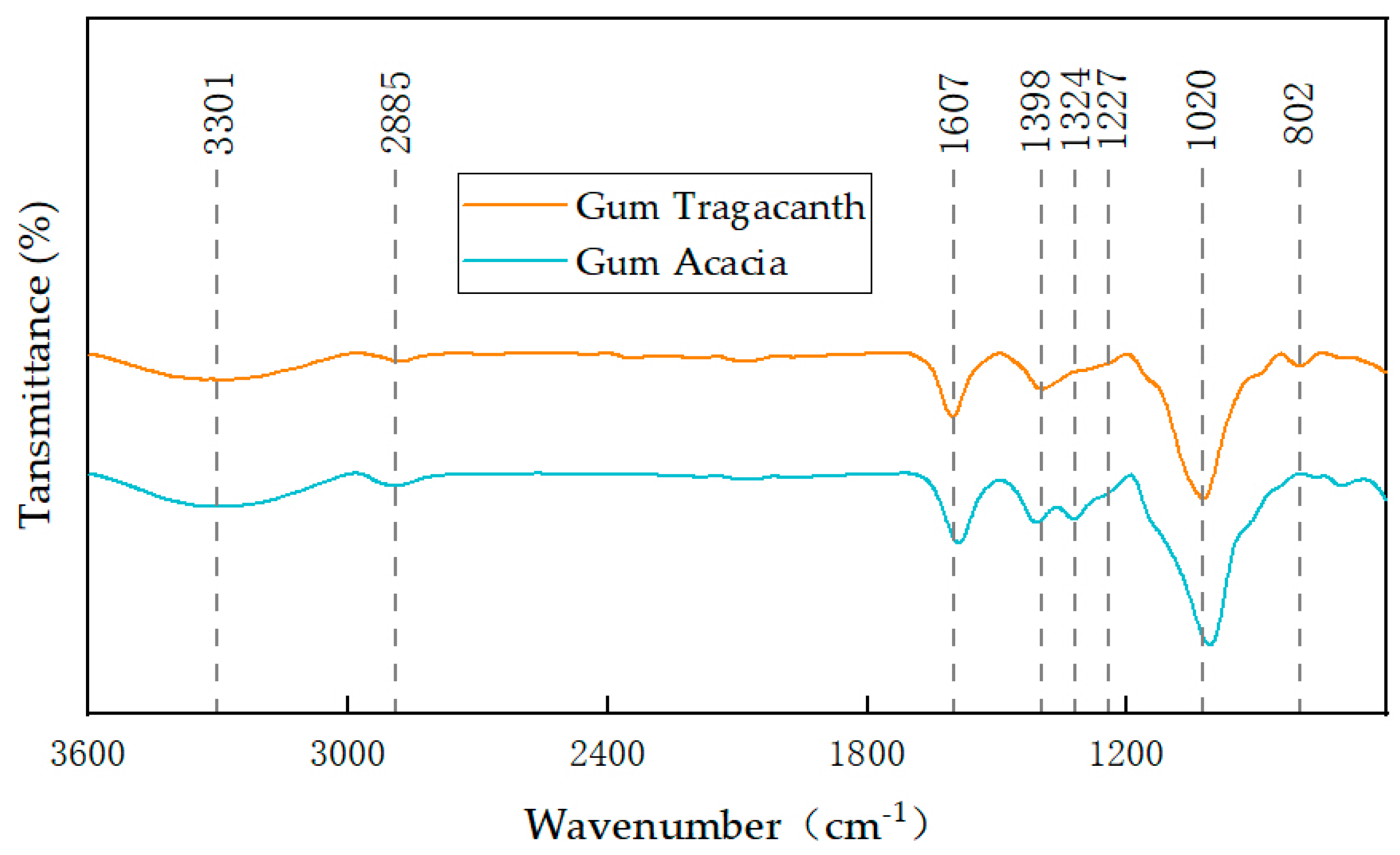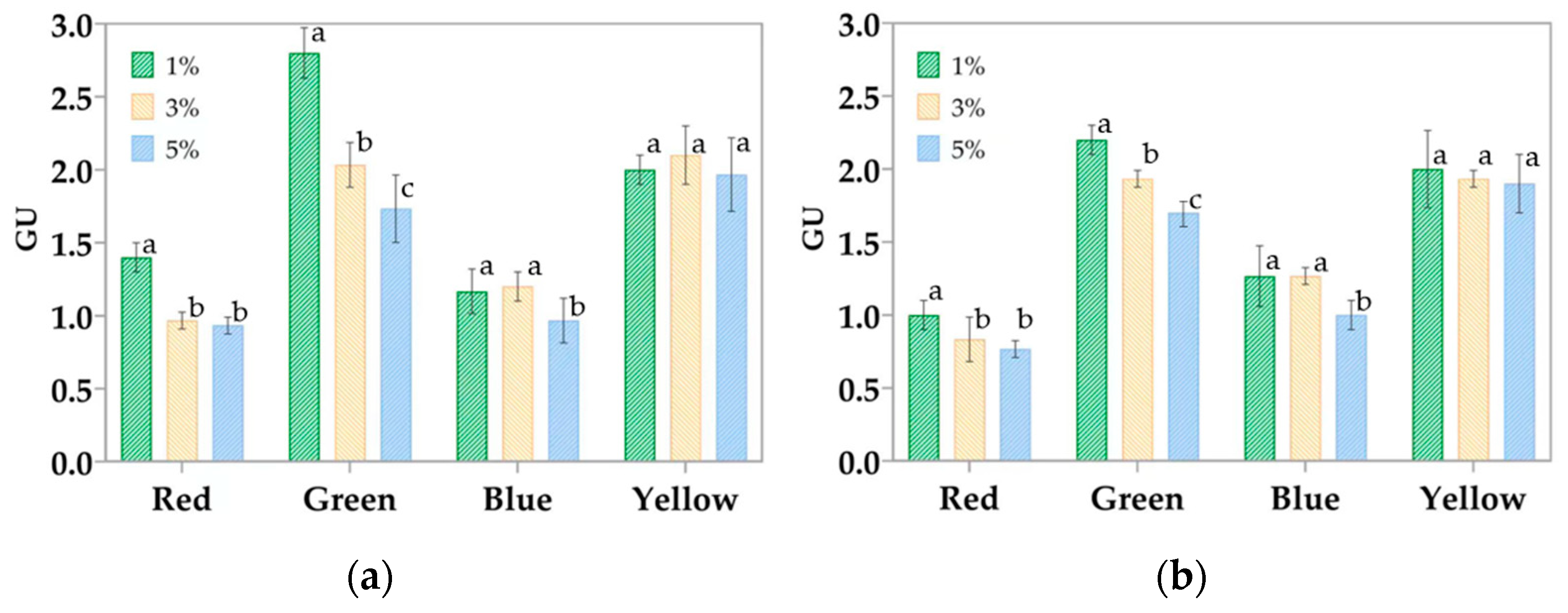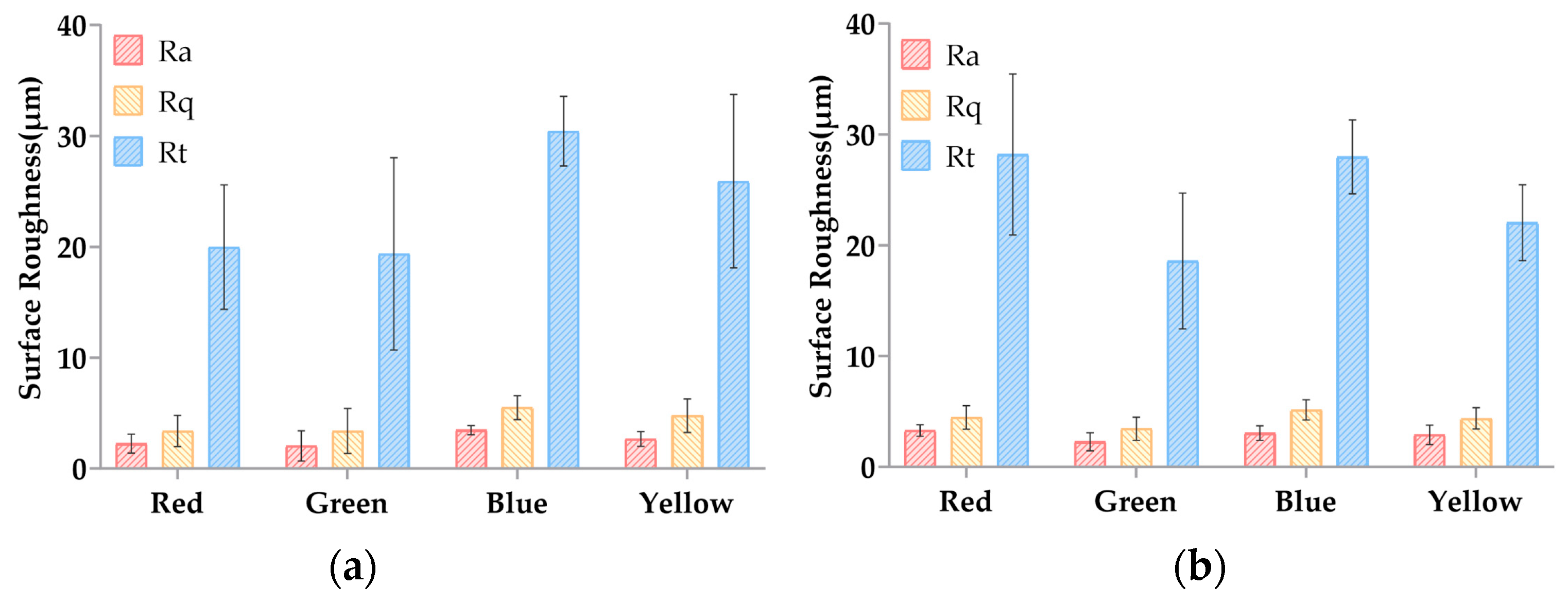Impact of Acacia and Tragacanth Gums on the Surface Characteristics of Traditional Wood-Supported Polychrome Paintings
Abstract
1. Introduction
2. Materials and Methods
2.1. Materials
2.2. Preparation of Polychrome Paintings
2.3. Characterization of Plant Gums
2.4. Evaluation Methods
2.4.1. Appearance and Color Evaluation
2.4.2. Gloss Evaluation
2.4.3. Surface Roughness Evaluation
2.5. Statistical Analysis
3. Results
3.1. Physicochemical Properties of Plant-Derived Gums
3.2. Color Characteristics of Polychrome Paintings
3.3. Gloss Analysis of Polychrome Paintings
3.4. Surface Roughness Analysis of Polychrome Paintings
4. Discussion
5. Conclusions
Supplementary Materials
Author Contributions
Funding
Institutional Review Board Statement
Informed Consent Statement
Data Availability Statement
Conflicts of Interest
References
- Shen, L.; Hua, D.; Nan, B.; Yao, Y.; Duan, H.; Wang, J. Material and technique analysis of Qing dynasty official style architectural polychrome paintings in Hangzhou, Zhejiang, China. Crystals 2025, 15, 92. [Google Scholar] [CrossRef]
- Riedo, C.; Scalarone, D.; Chiantore, O. Advances in identification of plant gums in cultural heritage by thermally assisted hydrolysis and methylation. Anal. Bioanal. Chem. 2010, 396, 1559–1569. [Google Scholar] [CrossRef]
- Lluveras-Tenorio, A.; Mazurek, J.; Restivo, A.; Colombini, M.P.; Bonaduce, I. Analysis of plant gums and saccharide materials in paint samples: Comparison of GC-MS analytical procedures and databases. Chem. Cent. J. 2012, 6, 115. [Google Scholar] [CrossRef]
- Xu, L.; Zhu, W.; Chen, X.; Liu, X. Applications and challenges of modern analytical techniques for the identification of plant gum in the polychrome cultural heritage. Coatings 2025, 15, 1042. [Google Scholar] [CrossRef]
- Sidorov, O.; Hardeberg, J.Y.; George, S.; Harvey, J.S.; Smithson, H.E. Changes in the visual appearance of polychrome wood caused by (accelerated) aging. Electron. Imaging 2020, 32, 60-1–60-8. [Google Scholar] [CrossRef]
- Bader, A.E.T.; Nabil, A.; Al-Gharib, W.K. Assessment of deterioration and conservation of a polychrome wooden coffin, from Al-Arish Museum, Egypt. Int. J. Conserv. Sci. 2013, 4, 409–420. [Google Scholar]
- Ali, M.; Kalil, H.; Mohamed, M. Examination and analysis of a painted wooden funerary stela from the late period at the Egyptian museum in Cairo. Egypt. J. Archaeol. Restor. Stud. 2022, 12, 187–196. [Google Scholar] [CrossRef]
- Balbas, D.Q.; Sánchez-Rodríguez, E.; Ramírez, Á.Z. Holy Corn. Interdisciplinary study of a Mexican 16th-century polychrome maize stem, paper, and colorín wood sculpture. Heritage 2021, 4, 1538. [Google Scholar] [CrossRef]
- Luo, L.; Zhou, P.; Zhu, H.; Zhang, B.; Hu, Y. A thorough detection of the mortar materials for buddhist buildings in Bagan, Myanmar. Eur. Phys. J. Plus 2023, 138, 151. [Google Scholar] [CrossRef]
- Lapshina, E.A.; Likhansky, Y.I.; Tolkacheva, A.A. State-of-the-Art Research Methodology for Restoration of Architectural Monuments. In IOP Conference Series: Earth and Environmental Science; IOP Publishing: Bristol, UK, 2020; Volume 459, p. 052032. [Google Scholar]
- Wu, M.; Zhang, B.; Zhang, Q.; Cheng, Q.; Jiang, S.; Li, L. Determination of peach gum in ancient Chinese paintings by biotin–streptavidin-enzyme-linked immunosorbent assay. Stud. Conserv. 2024, 69, 17–25. [Google Scholar] [CrossRef]
- Zhou, X.; Gong, Y.; Zhao, R.; Zhang, Y.; Gu, A.; Qu, Y.; Wang, Q. Scientific research and new evidence of the materials and craft of hard yellow paper. npj Herit. Sci. 2025, 13, 207 . [Google Scholar] [CrossRef]
- Emanuele, L.; Dujaković, T.; Roselli, G.; Campanelli, S.; Bellesi, G. The Use of a Natural Polysaccharide as a Solidifying Agent and Color-Fixing Agent on Modern Paper and Historical Materials. Organics 2023, 4, 265–276. [Google Scholar] [CrossRef]
- Casoli, A. Research on the Organic Binders in Archaeological Wall Paintings. Appl. Sci. 2021, 11, 9179. [Google Scholar] [CrossRef]
- Vyhnal, C.R.; Mahoney, E.H.R.; Lin, Y.; Radpour, R.; Wadsworth, H. Pigment Synthesis and Analysis of Color in Art: An Example of Applied Science for High School and College Chemistry Students. J. Chem. Educ. 2020, 97, 1272–1282. [Google Scholar] [CrossRef]
- Vinod, V.T.P.; Sashidhar, R.B.; Sarma, V.U.M.; Vijaya Saradhi, U.V.R. Compositional analysis and rheological properties of gum kondagogu (Cochlospermum gossypium): A tree gum from India. J. Agric. Food Chem. 2008, 56, 2199–2207. [Google Scholar] [CrossRef]
- Rahmaninia, M.; Rahmati, Y.; Tabarsa, M. Upgrading recycled paper using Astragalus gossypinus tragacanth gum as a bio-based additive. BioResources 2025, 20, 2. [Google Scholar] [CrossRef]
- Cleveland, I.; Beeby, A.; Vieira, M.; Pina, F.; Branco, P.S.; Nabais, P.; Melo, M.J. Natural colorants for a bio-based economy—Recovering a lost knowledge for novel applications of Chrozophora tinctoria extracts as paints through a multi-analytical approach. Molecules 2025, 30, 2860. [Google Scholar] [CrossRef]
- Kilic-Buyukkurt, O.; Guclu, G.; Kelebek, H.; Selli, S. Characterization of the key odorants of mastic gum (Pistacia lentiscus var. Chia) from two different countries. Appl. Sci. 2025, 15, 5329. [Google Scholar] [CrossRef]
- Shiam, M.A.H.; Islam, M.S.; Ahmad, I.; Haque, S.S. A review of plant-derived gums and mucilages: Structural chemistry, film forming properties and application. J. Plast. Film Sheeting 2025, 41, 195–237. [Google Scholar] [CrossRef]
- Chen, Y.; Guo, J.; Alamri, A.S.; Alhomrani, M.; Huang, Z.; Zhang, W. Recent research progress on locust bean gum (LBG)-based composite films for food packaging. Carbohydr. Polym. 2025, 348, 122815. [Google Scholar] [CrossRef]
- Salem, R.; Owais, A.; Salama, R. The conservation of an egyptian polychrome wood coffin from late period. Egypt. J. Archaeol. Restor. Stud. 2016, 6, 23–32. [Google Scholar] [CrossRef]
- Šefců, R.; Pitthard, V.; Dáňová, H.; Třeštíková, A. An analytical investigation of a unique medieval wood sculpture and its monochrome surface layer. Wood Sci. Technol. 2018, 52, 541–554. [Google Scholar] [CrossRef]
- Simas, F.F.; Gorin, P.A.; Wagner, R.; Sassaki, G.L.; Bonkerner, A.; Iacomini, M. Comparison of structure of gum exudate polysaccharides from the trunk and fruit of the peach tree (Prunus persica). Carbohydr. Polym. 2008, 71, 218–228. [Google Scholar] [CrossRef]
- Huang, D.; Han, K.; Teri, G.; Cheng, C.; Qi, Y.; Li, Y. Material and microstructure analysis of wood color paintings from Shaanxi Cangjie Temple, China. Molecules 2024, 29, 2734. [Google Scholar] [CrossRef]
- Ghervase, L.; Cortea, I.M. Lighting up the heritage sciences: The past and future of laser-induced fluorescence spectroscopy in the field of cultural goods. Chemosensors 2023, 11, 100. [Google Scholar] [CrossRef]
- Ji, H.; Yang, Y.; Zhang, H.; Li, B.; Cheng, L. Decay level classification of wooden components in tingbao yang’s former residence utilizing polarization and fluorescence effects. BioResources 2024, 19, 4087–4103. [Google Scholar] [CrossRef]
- Sharma, D.; Kumar, V.; Nautiyal, R.; Sharma, P. Rheological and nmr spectral data sets of quaternary ammonium derivative of Cassia tora linn. seed gum. Data Brief 2020, 29, 105271. [Google Scholar] [CrossRef]
- Lluveras-Tenorio, A.; Andreotti, A.; Talarico, F.; Legnaioli, S.; Olivieri, L.M.; Colombini, M.P.; Pannuzi, S. An insight into Gandharan art: Materials and techniques of polychrome decoration. Heritage 2022, 5, 488–508. [Google Scholar] [CrossRef]
- Eddy, N.O.; Abechi, S.E.; Ebenso, E.E. GCMS, FTIR, SEM, physiochemical and rheological studies on Albizia zygia gum. Walailak J. Sci. Technol. 2013, 10, 247–265. [Google Scholar]
- BS-EN 15886:2010; Conservation of Cultural Property—Test Methods—Colour Measurement of Surfaces. Svenska Institutet för Standardersis (SIS): Stockholm, Sweden, 2010.
- ISO 2813:2014; Paints and Varnishes—Determination of Gloss Value at 20°, 60° and 85°. ISO: Geneva, Switzerland, 2014.
- ISO 21920-1:2021; Geometrical Product Specifications (GPS)—Surface Texture: Profile. ISO: Geneva, Switzerland, 2021.
- Field, A. Discovering Statistics Using IBM SPSS Statistics, 5th ed.; SAGE Publications Ltd.: London, UK, 2024. [Google Scholar]
- Chen, Y.; Ge, X.; Zuo, S.; Wang, J. Effect of drying oil on properties of traditional painted coatings. Coatings 2024, 14, 1545. [Google Scholar] [CrossRef]
- Udo, I.; Odoemelam, S.; Okon, E. Physicochemical and FTIR studies on Acacia senegal and Anacardium occidentale Blends. J. Ind. Environ. Chem. 2017, 3, 101. [Google Scholar]
- Teimouri, S.; Abbasi, S.; Sheikh, N. effects of gamma irradiation on some physicochemical and rheological properties of persian gum and gum tragacanth. Food Hydrocoll. 2016, 59, 9–16. [Google Scholar] [CrossRef]
- Liang, H.; Wu, Z. The role of single landscape elements in enhancing landscape aesthetics and the sustainable tourism experience: A case study of leisure furniture. Sustainability 2024, 16, 10219. [Google Scholar] [CrossRef]
- Thombare, N.; Mahto, A.; Singh, D.; Chowdhury, A.R.; Ansari, M.F. Comparative FTIR characterization of various natural gums: A criterion for their identification. J. Polym. Environ. 2023, 31, 3372–3380. [Google Scholar] [CrossRef]
- Daoub, R.M.; Elmubarak, A.H.; Misran, M.; Hassan, E.A.; Osman, M.E. Characterization and functional properties of some natural Acacia gums. J. Saudi Soc. Agric. Sci. 2018, 17, 241–249. [Google Scholar] [CrossRef]
- Mothé, C.G.; Rao, M.A. Rheological behavior of aqueous dispersions of cashew gum and gum arabic: Effect of concentration and blending. Food Hydrocoll. 1999, 13, 501–506. [Google Scholar] [CrossRef]
- Ferrero, A.; Bernad, B.; Campos, J.; Perales, E.; Velázquez, J.L.; Martínez-Verdú, F.M. Color characterization of coatings with diffraction pigments. J. Opt. Soc. Am. A 2016, 33, 1978–1988. [Google Scholar] [CrossRef] [PubMed]
- Shabannejad, M.; Nourbakhsh, M.S.; Nezafati, N.; Nazemi, Z.; Nemati, F. Periodate oxidation of tragacanth gum and evaluation of physicochemical and biological properties of oxidized tragacanth gum. Sci. Rep. 2025, 15, 30214. [Google Scholar] [CrossRef] [PubMed]
- Croll, S.G. Surface roughness profile and its effect on coating adhesion and corrosion protection: A review. Prog. Org. Coat. 2020, 148, 105847. [Google Scholar] [CrossRef]






| Painting Type | Color Coordinates | Gum Type | Concentration | Gum Type × Concentration |
|---|---|---|---|---|
| Blue painting | L* | <0.001 | 0.746 | 0.879 |
| a* | <0.001 | 0.783 | 0.798 | |
| b* | <0.001 | 0.764 | 0.769 | |
| Yellow painting | L* | 0.069 | 0.703 | 0.853 |
| a* | <0.001 | 0.784 | 0.744 | |
| b* | 0.059 | 0.566 | 0.624 | |
| Green painting | L* | 0.244 | 0.875 | 0.896 |
| a* | <0.001 | 0.456 | 0.677 | |
| b* | <0.001 | 0.632 | 0.745 | |
| Red painting | L* | <0.001 | <0.001 | <0.001 |
| a* | <0.001 | 0.124 | 0.215 | |
| b* | <0.001 | 0.237 | 0.267 |
| Painting Type | Gum Type | Concentration | Gum Type × Concentration |
|---|---|---|---|
| Blue painting | 0.324 | 0.014 | 0.916 |
| Yellow painting | 0.412 | 0.739 | 0.761 |
| Green painting | 0.019 | <0.001 | 0.373 |
| Red painting | 0.005 | <0.001 | 0.916 |
| Painting Type | Roughness | Gum Type | Concentration | Gum Type × Concentration |
|---|---|---|---|---|
| Blue painting | Ra | 0.440 | 0.358 | 0.099 |
| Rq | 0.970 | 0.159 | 0.588 | |
| Rt | 0.822 | 0.699 | 0.787 | |
| Yellow painting | Ra | 0.045 | 0.508 | 0.484 |
| Rq | 0.246 | 0.136 | 0.685 | |
| Rt | 0.819 | 0.195 | 0.814 | |
| Green painting | Ra | 0.618 | <0.001 | 0.549 |
| Rq | 0.879 | <0.001 | 0.918 | |
| Rt | 0.959 | <0.001 | 0.849 | |
| Red painting | Ra | <0.001 | <0.001 | 0.650 |
| Rq | 0.538 | 0.041 | 0.597 | |
| Rt | 0.926 | 0.002 | 0.773 |
Disclaimer/Publisher’s Note: The statements, opinions and data contained in all publications are solely those of the individual author(s) and contributor(s) and not of MDPI and/or the editor(s). MDPI and/or the editor(s) disclaim responsibility for any injury to people or property resulting from any ideas, methods, instructions or products referred to in the content. |
© 2025 by the authors. Licensee MDPI, Basel, Switzerland. This article is an open access article distributed under the terms and conditions of the Creative Commons Attribution (CC BY) license (https://creativecommons.org/licenses/by/4.0/).
Share and Cite
Liu, X.; Feng, Y.; Xia, M.; Liu, X.; Beldean, E.C.; Chen, Y. Impact of Acacia and Tragacanth Gums on the Surface Characteristics of Traditional Wood-Supported Polychrome Paintings. Coatings 2025, 15, 1233. https://doi.org/10.3390/coatings15111233
Liu X, Feng Y, Xia M, Liu X, Beldean EC, Chen Y. Impact of Acacia and Tragacanth Gums on the Surface Characteristics of Traditional Wood-Supported Polychrome Paintings. Coatings. 2025; 15(11):1233. https://doi.org/10.3390/coatings15111233
Chicago/Turabian StyleLiu, Xiaochen, Yuemin Feng, Meng Xia, Xinyou Liu, Emanuela Carmen Beldean, and Yushu Chen. 2025. "Impact of Acacia and Tragacanth Gums on the Surface Characteristics of Traditional Wood-Supported Polychrome Paintings" Coatings 15, no. 11: 1233. https://doi.org/10.3390/coatings15111233
APA StyleLiu, X., Feng, Y., Xia, M., Liu, X., Beldean, E. C., & Chen, Y. (2025). Impact of Acacia and Tragacanth Gums on the Surface Characteristics of Traditional Wood-Supported Polychrome Paintings. Coatings, 15(11), 1233. https://doi.org/10.3390/coatings15111233





